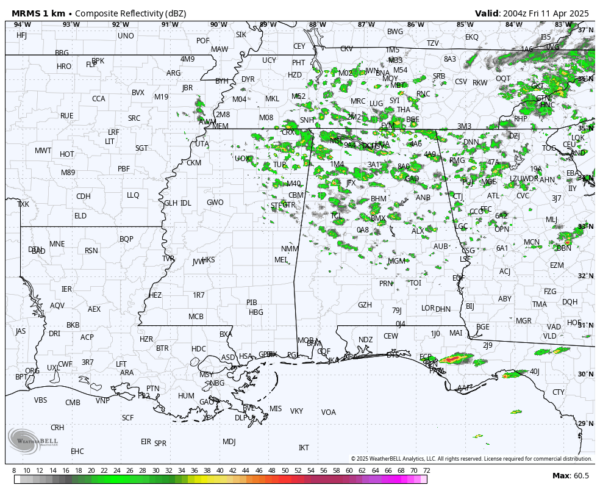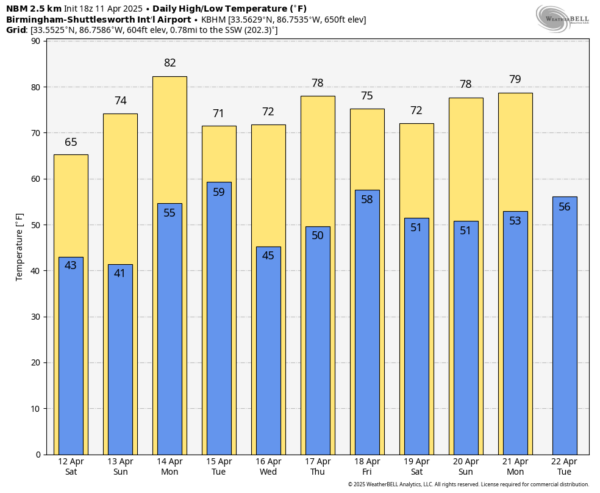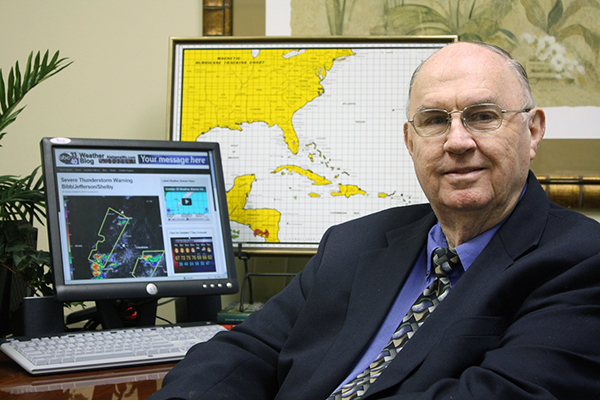Dry Weekend Ahead; Cool Mornings, Pleasant Afternoons
RADAR CHECK: As expected we have scattered showers over the northern half of Alabama this afternoon as a deep upper trough moves through. Because the air aloft is so cold, some of the showers are producing small pea sized hail. Otherwise we have a mix of sun and clouds with temperatures in the 60s over the northern counties; 70s are observed to the south.
Scattered showers will end this evening; the sky becomes mostly fair tonight with a low in the 40s.
THE WEEKEND: For a change, we have no storms to deal with. Expect a sun filled sky both days… the high tomorrow will be in the mid to upper 60s, followed by 70s Sunday. Mornings will be cool with lows in the 38-44 degree range. It is possible some of the colder spots over North Alabama could see some light frost, but nothing widespread.
NEXT WEEK: The weather looks pretty quiet through the week. Temperatures reach the low 80s Monday; highs over the rest of the week will be mostly in the 70s. Surface fronts will bring a few isolated showers Tuesday morning, and then again Friday, but rain amounts should be light, and we see no risk of heavy rain or severe storms through the week. See the video briefing for maps, graphics, and more details.
ON THIS DATE IN 1965: The “Palm Sunday” tornado outbreak produced 55 confirmed tornadoes in one day and 16 hours. The worst part of the outbreak occurred during the afternoon hours of April 11 into the overnight hours going into April 12. The second-largest tornado outbreak on record at the time, this deadly series of tornadoes inflicted a swath of destruction from Cedar County, Iowa, to Cuyahoga County, Ohio, and a swath 450 miles long from Kent County, Michigan, to Montgomery County, Indiana. The main part of the outbreak lasted 16 hours and 35 minutes and is among the most intense outbreaks, in terms of tornado strength, ever recorded, including at least four “double/twin funnel” tornadoes. In all, the outbreak killed 266 people, injured 3,662 others
Dr. Ted Fujita discovered suction vortices during the Palm Sunday tornado outbreak. It had been believed the reason why tornadoes could hit one house and leave another across the street completely unscathed was because the whole tornado would “jump” from one house to another. However, the actual reason is because most of the destruction is caused by suction vortices: smaller, rapidly spinning whirls within a tornado circulation.
ON THIS DATE IN 2007: Severe thunderstorms, some with large hail, moved across Alabama. Five tornadoes touched down, all rated EF-0 or EF-1, including one near Bagley in far Northwest Jefferson County.
Look for the next video briefing here by 6:00 a.m. Monday… enjoy the weekend!
Category: Alabama's Weather, ALL POSTS, Weather Xtreme Videos

















